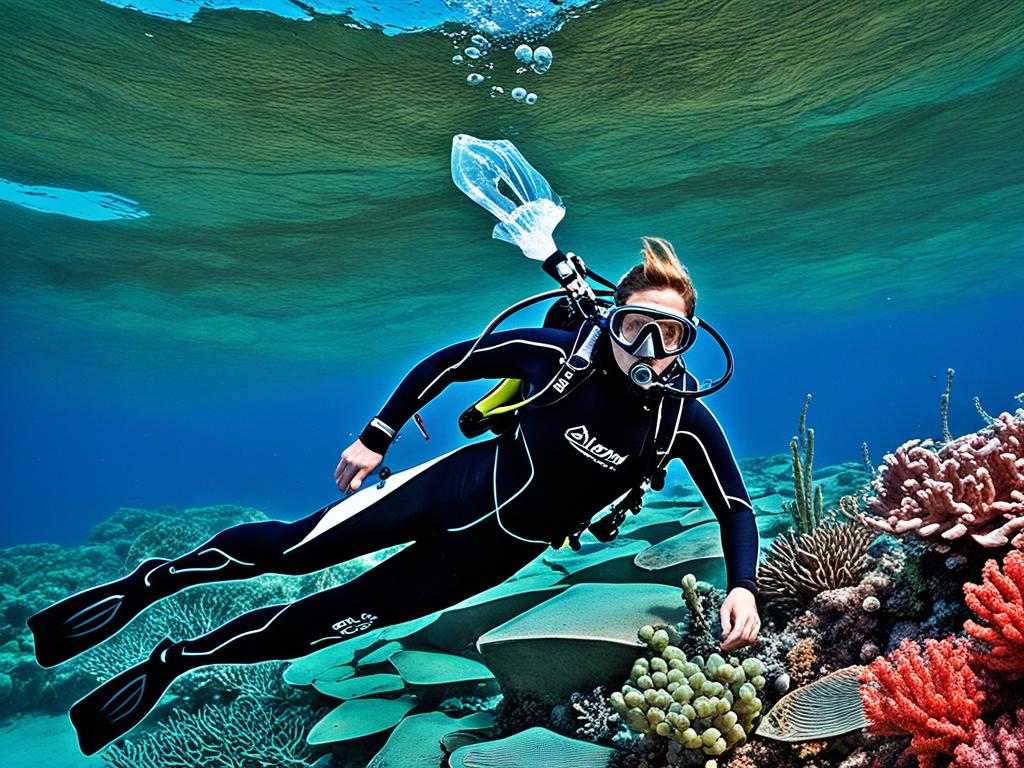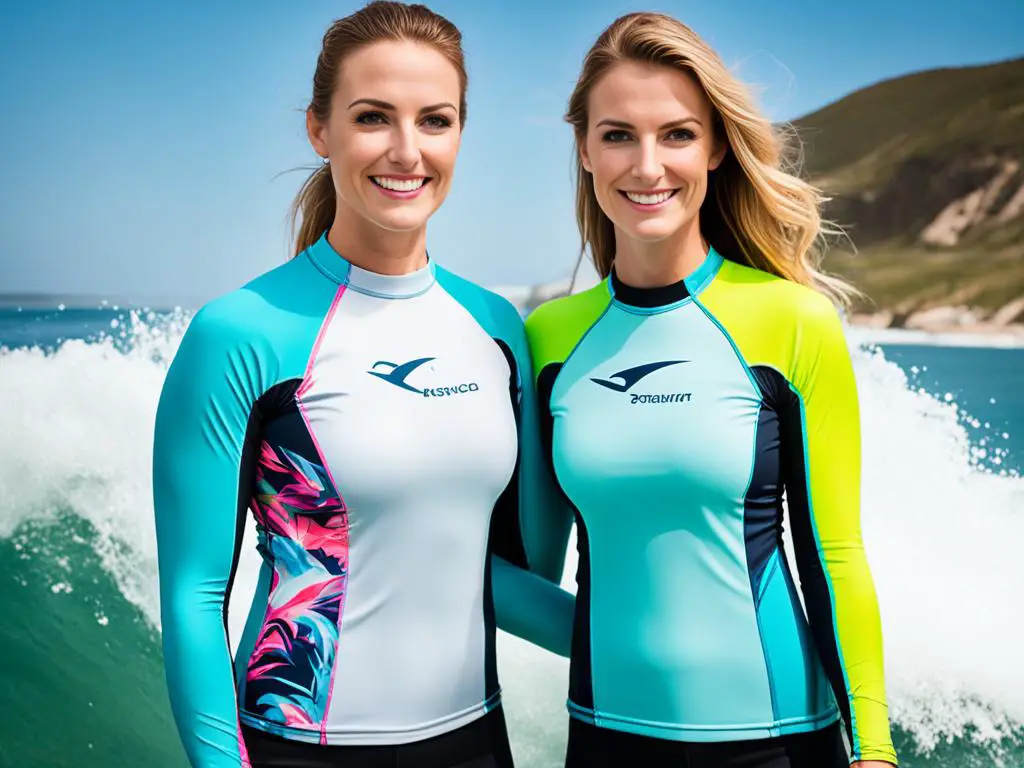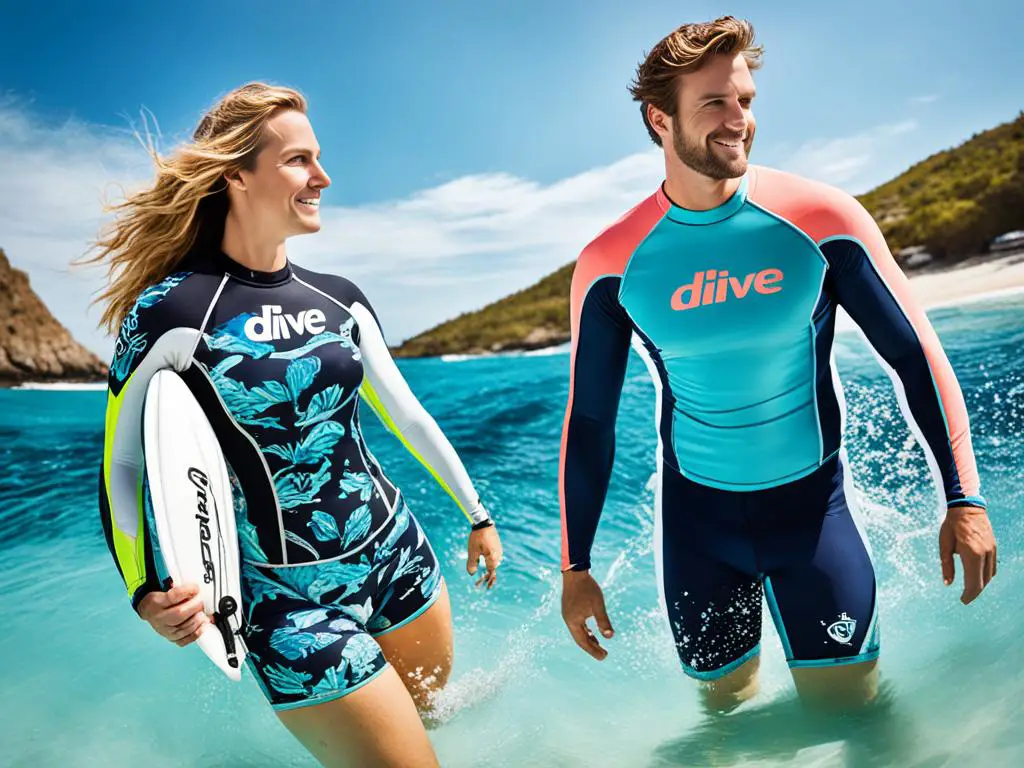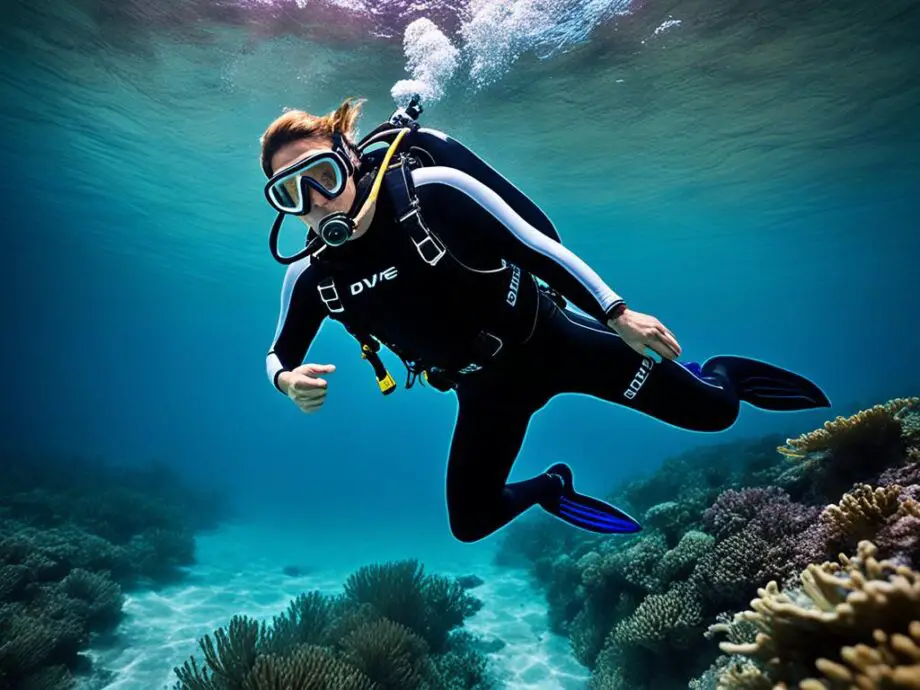When it comes to scuba diving apparel and water sports clothing, two popular options that often come into consideration are dive skins and rash guards. While both garments serve a similar purpose of providing protection and comfort, they possess distinct features that set them apart. In this article, we will explore the main differences between dive skins and rash guards, allowing you to make an informed decision for your next water adventure.
Firstly, let’s delve into the world of dive skins. Designed specifically for scuba divers, dive skins are lightweight and form-fitting garments that provide an extra layer of thermal protection and help to reduce water drag. Made from a blend of spandex and nylon materials, dive skins offer flexibility and a snug fit, enabling divers to move effortlessly through the water. With their UV protection properties, they also shield the skin from harmful sun rays during prolonged exposure.
On the other hand, rash guards are versatile water sports clothing that find their application in various activities like scuba diving, surfing, and snorkeling. Constructed from a blend of polyester and spandex, rash guards provide a comfortable and breathable layer that protects the skin from abrasions, jellyfish stings, and sunburn. The quick-drying fabric of rash guards ensures that moisture is efficiently wicked away from the skin.
Now, let’s compare these two options side by side. Dive skins, with their form-fitting design, provide an excellent range of motion and minimal water resistance. Their tight fit also prevents chafing and irritation, making them ideal for long hours of diving. On the other hand, rash guards offer a looser fit, allowing for easy removal and additional layering of wetsuits if needed. This versatility makes rash guards suitable for different water temperatures and activities.
To sum it up, choosing the right scuba diving apparel requires understanding the differences between dive skins and rash guards. Dive skins offer enhanced thermal protection and UV resistance, while rash guards provide versatile functionality and sun protection. Assess your diving needs, preferences, and the environmental conditions to determine which garment will best suit your requirements.
Key Takeaways:
- Dive skins and rash guards are scuba diving apparel options with distinct features and benefits.
- Dive skins offer thermal protection, UV resistance, and a form-fitting design.
- Rash guards provide versatility, sun protection, and quick-drying properties.
- Consider factors like fit, functionality, and environmental conditions when choosing between dive skins and rash guards.
- Both options ensure comfort and protection, allowing you to enjoy your water sports activities to the fullest.
Understanding Dive Skins
Dive skins are an essential component of scuba diving apparel, offering numerous benefits to divers. Not only are they stylish and comfortable, but they also provide valuable protection against the sun’s harmful UV rays, making them a vital piece of UV protection clothing.
One of the key advantages of dive skins is their lightweight and snug fit. Made from specialized fabrics, these skins cling to the body, allowing for easy movement underwater. The close-fitting design reduces drag and ensures optimal hydrodynamics, enabling divers to navigate through the water effortlessly.
Additionally, dive skins offer excellent UV protection, shielding the wearer from the sun’s harmful rays. With a high UPF (Ultraviolet Protection Factor), these skins effectively block out UVA and UVB radiation. This is particularly crucial for prolonged periods spent in the water, as the reflection of sunlight can intensify the exposure and increase the risk of sunburn and long-term skin damage.
Aside from UV protection, dive skins provide an extra layer of insulation. They help to regulate body temperature by trapping a thin layer of water close to the skin, acting as a protective barrier against the cold. This is especially beneficial for divers who frequent colder waters or dive at greater depths.
Dive skins also offer added defense against abrasive elements like jellyfish stings, coral scrapes, and minor cuts. The smooth surface of the skin reduces friction, minimizing the chances of injury while exploring underwater environments. Moreover, some dive skins come with integrated rash guard features, providing additional protection and comfort.
Dive Skin Benefits:
- Optimal UV protection
- Lightweight and hydrodynamic design
- Enhanced insulation in colder waters
- Protection against abrasive elements
Overall, dive skins are a versatile and indispensable piece of scuba diving gear. Their practical benefits, UV protection properties, and ability to enhance comfort and performance make them a preferred choice for divers of all experience levels.

Unveiling the Features of Rash Guards
When it comes to scuba diving apparel, rash guards are a popular choice due to their versatile features and functionality. Designed specifically for water sports activities, rash guards offer protection and comfort in various aquatic environments. Let’s explore the key features that make rash guards an essential part of any diver’s wardrobe.
Material
Rash guards are typically made from high-quality, quick-drying materials such as nylon or spandex. These fabrics provide a snug fit without compromising freedom of movement. The lightweight and breathable nature of rash guard materials ensure optimal comfort during prolonged dives.
Design
Rash guards are designed with flatlock stitching to minimize skin irritation and chafing. This seamless construction not only enhances comfort but also helps to prevent rashes caused by friction against equipment or underwater surfaces. Additionally, rash guards often feature raglan sleeves, which allow for a full range of motion while diving.
UV Protection
One of the key advantages of rash guards is their ability to provide sun protection. These garments are engineered with UPF (Ultraviolet Protection Factor) technology, which shields the wearer’s skin from harmful UV rays. Whether diving in tropical waters or exposed to intense sunlight, rash guards offer reliable sun protection.
Quick-Drying
Rash guards excel in their quick-drying capabilities, making them perfect for scuba diving. Their moisture-wicking properties ensure that excess water evaporates rapidly, keeping divers comfortable throughout their underwater adventures. This feature is particularly crucial in preventing the body from losing heat too quickly, which can lead to hypothermia.
Added Skins Protection
In addition to offering UV protection, rash guards serve as an extra layer of defense against common irritants like jellyfish stings, sea lice, and coral scrapes. The tight-fitting nature of rash guards creates a barrier between the skin and potential hazards, significantly reducing the risk of skin damage during dives.
“Rash guards provide divers with both comfort and protection. Their lightweight design, UV resistance, and added skin protection make them an ideal choice for scuba diving and other water sports activities.” – [Expert Diver Name]
Overall, rash guards are an essential piece of scuba diving apparel. With their durable materials, functional design, and valuable features, they offer unmatched comfort and protection for divers of all experience levels. Whether exploring coral reefs or embarking on adrenaline-filled dives, rash guards are a reliable companion beneath the waves.

Dive Skin vs Rash Guard: A Comparative Analysis
When it comes to scuba diving apparel and water sports clothing, two popular options that divers often consider are dive skins and rash guards. While both serve the purpose of providing protection and enhanced performance in the water, they have distinct features that differentiate them from each other. In this section, we will compare dive skins and rash guards side by side, highlighting their similarities and differences. This comparison will help you make an informed decision about which option suits your scuba diving needs best.
Comfort and Flexibility
Both dive skins and rash guards are designed with comfort and flexibility in mind. Dive skins are typically made from a thin and stretchable material, such as neoprene, which provides a snug fit and allows for ease of movement underwater. Rash guards, on the other hand, are usually made from lightweight and breathable fabrics like nylon or lycra, offering excellent flexibility and ensuring maximum comfort during prolonged water activities.
Water Resistance
When it comes to water resistance, dive skins and rash guards differ in their capabilities. Dive skins, with their neoprene construction, provide a higher level of water resistance, acting as an additional barrier between your skin and the water. This feature is particularly beneficial for diving in colder waters or for prolonged exposure to water. Rash guards, although not specifically designed for water resistance, still offer some protection against water, making them suitable for warmer environments or shorter dives.
Protection Against Elements
Dive skins and rash guards also differ in their ability to provide protection against the elements. Dive skins, with their thicker neoprene material, offer superior insulation against colder water temperatures, shielding the body from the cold and reducing heat loss. Additionally, dive skins provide UV protection, guarding the skin against harmful sun rays during surface intervals. Rash guards, on the other hand, are primarily designed to protect against sunburn and abrasions caused by underwater objects, providing a layer of defense without compromising comfort and flexibility.
Overall, the choice between a dive skin and a rash guard depends on your specific diving needs and preferences. If you prioritize water resistance and enhanced insulation in colder environments, a dive skin may be the ideal choice for you. On the other hand, if you value flexibility, breathability, and sun protection, a rash guard would be a suitable option. Consider the conditions you typically dive in and the level of protection you require to make an informed decision.

| Dive Skin | Rash Guard | |
|---|---|---|
| Material | Thicker neoprene | Lightweight nylon or lycra |
| Comfort | Tight fit, ease of movement | Lightweight, breathable |
| Water Resistance | High | Moderate |
| Protection | Insulation, UV protection | Sunburn, abrasion protection |
Choosing the Best Rash Guard for Diving
When it comes to scuba diving apparel, a rash guard is an essential piece of water sports clothing. Not only does it provide protection against the sun’s harmful rays, but it also offers added comfort and style during your dives. To ensure you select the best rash guard for diving, here are key factors to consider:
- Fit: Look for a rash guard that offers a snug yet flexible fit. It should allow for easy movement underwater without feeling constricting.
- Material Quality: Opt for high-quality materials such as nylon or polyester blends that are quick-drying and offer excellent breathability.
- Sun Protection Rating: Check for a rash guard with a UPF (Ultraviolet Protection Factor) rating of at least 50+. This ensures adequate protection against the sun’s harmful UVA and UVB rays.
- Additional Features: Consider rash guards with features like built-in thumb loops for secure fit, flatlock stitching for chafe-free comfort, and reinforced panels for durability.
Apart from these factors, it’s also worth considering the design and color options that suit your personal style. As with any scuba diving apparel, it’s important to choose a rash guard that not only meets functional requirements but also makes you feel confident during your underwater adventures.
Remember, the best rash guard for diving is one that combines comfort, protection, and style seamlessly. So, take your time to explore the options available and choose a rash guard that fits your diving needs perfectly.
Top-Rated Rash Guards for Diving
| Rash Guard | Material | Sun Protection Rating | Additional Features |
|---|---|---|---|
| Brand A Rash Guard | Nylon/Spandex Blend | UPF 50+ | Thumb Loops, Flatlock Stitching |
| Brand B Rash Guard | Polyester/Spandex Blend | UPF 50+ | Reinforced Panels, Quick-Drying |
| Brand C Rash Guard | Nylon/Elastane Blend | UPF 50+ | Adjustable Hood, Breathable |
These top-rated rash guards offer a combination of superior quality, sun protection, and additional features that make them ideal for diving. Consider your personal preferences and requirements when making your selection, and enjoy your dives with confidence and comfort.
Conclusion
After analyzing the differences between dive skins and rash guards, it is clear that both options have their unique advantages for scuba diving and water sports activities. Dive skins, with their lightweight and skin-tight design, provide excellent UV protection and can enhance buoyancy in the water. On the other hand, rash guards offer more flexibility and durability, making them a popular choice among divers.
When selecting scuba diving apparel, it is crucial to consider personal preferences, the specific activity, and the conditions in which you will be diving. Dive skins are particularly beneficial for individuals who prioritize sun protection and prefer a streamlined fit. Rash guards, on the other hand, excel in terms of comfort and versatility, allowing divers to move freely in the water.
Looking ahead, advancements in dive skin technology show promising potential for the future of water sports clothing. Manufacturers are continuously innovating to improve the breathability, insulation, and durability of dive skins. These advancements aim to provide divers with even greater comfort and protection in various environmental conditions, further enhancing their overall diving experience.
